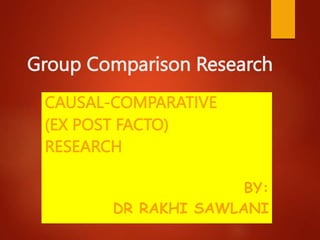
causalcomp-DrRakhiS.ppt
- 1. Group Comparison Research CAUSAL-COMPARATIVE (EX POST FACTO) RESEARCH BY: DR RAKHI SAWLANI
- 2. Purpose Attempts to determine cause for Existing conditions Preexisting differences in groups Alleged cause and effect have already occurred Orientations Retrospective (basic): starts with an effect and seeks possible causes Prospective (variation): starts with a cause and investigates its effects on some variable
- 3. Features The independent variable (IV) is not manipulated; it has already occurred Independent variables sometimes called “attribute variables” Less costly and time-consuming to conduct Establishing cause-effect relationships is more difficult than in experiments
- 4. Procedures Identify an existing condition /event (e.g., differences in socialization among 1st grade students) Look “backwards” to see what may have caused this difference /condition to occur (i.e., some attended preschool, some did not) Rule out other causal factors
- 6. Sometimes confused with correlational research: Both lack manipulation of variables Both require caution in interpreting results Both can support subsequent experimental research
- 7. Causal comparative vs. Correlational research Causal comparative Attempts to identify cause-effect relationships At least one independent variable Two or more groups Involves a comparison Correlational No attempt to understand cause and effect Two or more variables Only one group
- 8. Sometimes confused with experimental research: Both try to establish cause-effect relationships Both can test hypotheses concerning the relationship between an independent (X) and a dependent variable (Y) Both involve group comparisons
- 9. Comparison to experiments Causal comparative Individuals already in groups before study begins Independent variable has already occurred Independent variable is not manipulated Cannot be Should not be Could be, but is not Experiment Individuals randomly assigned to groups (e.g., treatment or control) Independent variable manipulated by the researcher
- 10. Examples of non-manipulated independent variables Age Sex Ethnicity “Learning style” Socioeconomic status (SES) Parent educational level Family environment Type of school attended
- 11. Design of causal-comparative research Select 2 groups that differ on some IV One group possesses a characteristic that the other does not Each group possesses the characteristic, but in differing amounts Randomly sample Ss from each group Collect info on Ss to determine equality of the groups Compare groups on the DV
- 12. Difficulty in interpreting findings Establishing cause and effect requires caution! Alternative explanations: Different causal variable Order of causation Reverse causality Order of occurrence
- 13. Evidence necessary to demonstrate that X causes Y: Establish statistical relationship between X and Y (i.e., correlational research); determine that X precedes Y in time (collect data over time, i.e., longitudinal research); demonstrate that other, unknown factors did not determine the dependent variable (i.e., experimental research).
- 14. Becker & Gersten (1982): “Effects of Project Follow-Through…” Quasi-experimental study Ex post facto study Problem: Are the two groups in this study comparable to one another?
- 15. In order to make sure that the two groups are comparable, and to ensure that the only post-test differences between the groups are due to the independent variable (the Follow-Through intervention), data were obtained on students’: family income gender language spoken in home mother’s education ethnicity number of siblings.
- 16. Research Design FOLLOW-THROUGH Year 1 (1975) Gr 5 Site 1 Site 2 Site 3 Site 4 Site 5 Year 2 (1976) Gr 6 Site 1 Site 2 Site 3 Site 4 Site 5 NO FOLLOW-THROUGH Year 1 (1975) Gr 5 Site 1 Site 2 Site 3 Site 4 Site 5 Year 2 (1976) Gr 6 Site 1 Site 2 Site 3 Site 4 Site 5
- 17. Dependent variables Wide-Range Achievement Test (WRAT) reading mathematics Metropolitan Achievement Test (MAT) reading mathematics
- 18. RESULTS A total of 180 comparisons of FT to No-FT students. Of these, only 56 (31%) favored FT students! Largest differences between FT and No-FT students were in basic skills areas. FT students’ achievement declined by grades 5 and 6 (2-3 years after end of FT).
- 19. Critique of this research What are the strengths of the study? Groups are comparable to one another. Contrasted statistical with practical significance. Large sample size. Multiple “replications” of treatment effect. What are the weaknesses of the study? Lack of random assignment. Focus on standardized test performance.
